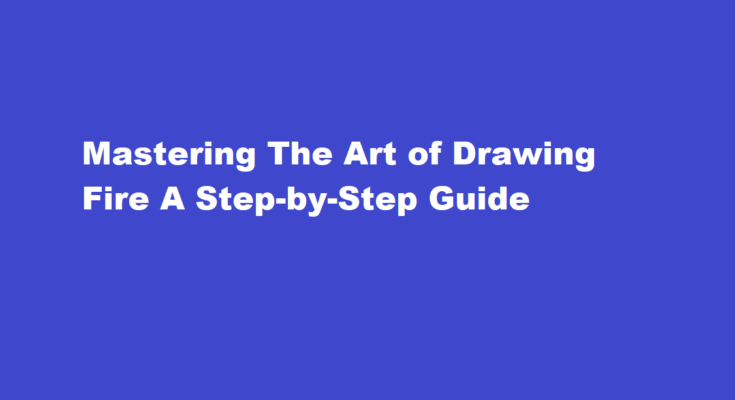Introduction
Fire has fascinated humanity for millennia, mesmerizing us with its dance of flames and the warmth it brings. Capturing the essence of fire in a drawing can be a challenging yet rewarding endeavor for artists of all levels. In this article, we will explore a step-by-step guide to help you master the art of drawing fire. Whether you’re a beginner or an experienced artist, these techniques will help you create stunning, lifelike representations of fire in your artwork.
Gather Your Materials
Before you start, ensure you have the right materials at hand. You will need quality drawing paper, pencils (preferably soft ones like charcoal or pastel pencils), erasers, and blending tools like stumps or tortillons. Additionally, colored pencils or pastels can be handy for adding vibrant hues to your fire drawing.
Understand Fire’s Anatomy
To draw fire convincingly, you must understand its anatomy. Fire consists of various elements, including flames, heat, and smoke. Flames have a distinctive shape, starting narrow at the base and widening as they rise. Heat creates distortion in the air, while smoke adds depth and dimension. Study reference images of fire to familiarize yourself with its structure and movement.
Start with Basic Shapes
Begin by sketching the basic shapes of your fire. Use light, flowing lines to create the contours of the flames. Pay attention to the way the flames curl, twist, and dance. Remember that fire is dynamic, so each flame may have a unique shape and direction. Avoid hard edges, as fire is a constantly shifting and ethereal element.
Add Shadows and Highlights
Once you have your basic flame shapes, start adding shadows and highlights. Use a softer pencil or charcoal to darken the areas where the flames overlap or where they are in the background. Conversely, use a white pencil or eraser to create highlights where the flames catch the light. This contrast between light and shadow will give your drawing depth and make the flames appear more three-dimensional.
Incorporate Color
Fire is a vibrant source of color, ranging from deep reds and oranges to bright yellows and whites. To capture the fiery hues, use colored pencils or pastels to add layers of color to your drawing. Start with the darkest shades at the base of the flames and gradually transition to lighter colors toward the tips. Blend the colors together using a blending tool or your fingers for a smooth, seamless look.
Emphasize the Heat
To convey the intense heat of fire, you can add distortion effects in the surrounding air. Use soft, wavy lines around the flames to simulate the shimmering heat waves. This will create a realistic impression of the heat radiating from the flames. Be subtle with this effect, as it should enhance the drawing without overpowering it.
Work on the Smoke
Fire often produces smoke, which adds drama and realism to your drawing. Use soft, feathery strokes to create wisps of smoke rising from the flames. The smoke should have a slightly grayish tint and should be more transparent near the flames, gradually becoming denser as it moves upward.
FREQUENTLY ASKED QUESTIONS
How do you pencil sketch flames?
Use curvy shading to give the fire movement. Whether you are drawing it with graphite or colored pencils, the stroke of your pencil should be the same: upward to make it seem as if the fire is rising, and curvy lines at the tip of the flames for a dynamic feel.
How can kids make a fire?
A teepee tends to be a great and easy starting place. For the teepee/cone method, make a small teepee/cone of kindling around a few handfuls of tinder that are loosely piled in the center of the fire ring. Your tinder goes at the base of the fire and then your kindling is placed over it in a tent/cone shape.
Is it easy to create fire?
Even if you’re not a master of the outdoors, building a fire is quite easy and a very practical skill to have in your back pocket. From gathering your kindling and firewood to lighting everything ablaze, we’ll walk you through the process of building a fire step-by-step.
Conclusion
Drawing fire requires a keen understanding of its anatomy and a careful approach to capturing its dynamic nature. With the right materials and techniques, you can create stunning representations of fire that evoke its warmth, movement, and mesmerizing beauty. Practice, study, and experiment, and soon you’ll be able to master the art of drawing fire.
Read Also : The Art of Bubblegum Bliss A Guide to Blowing Perfect Bubbles



